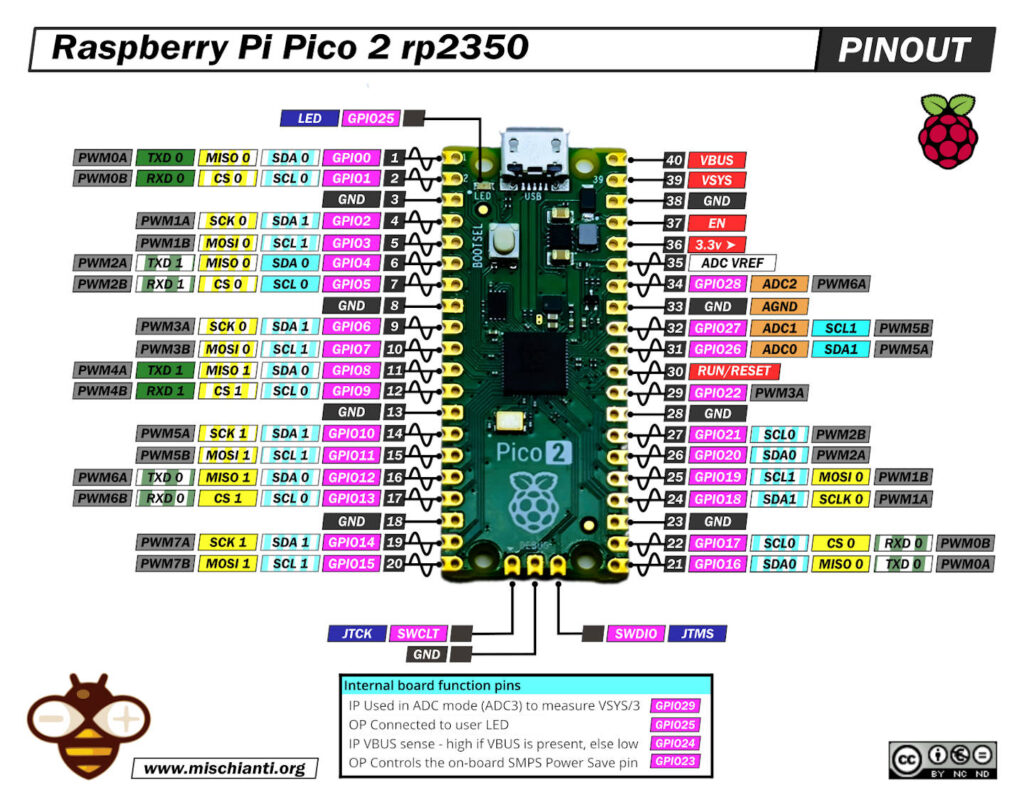Raspberry Pi Pico 2: high-resolution pinout, datasheet, and specs

Raspberry Pi Pico 2 high resolution pinout image
Here where to buy my selection of rp2040 devices Official Pi Pico - Official Pi Pico W - Waveshare rp2040-zero - WeAct Studio rp2040
PINs
Power Pins
- VBUS – micro-USB input voltage
- VSYS – main system input voltage
- 3V3 – regulated 3.3V output, 300mA max
- GND – main ground reference
- AGND – ground reference for GP26-29 and ADC0 and ADC1
GPIO Pins
- GP0 to GP28 – General Purpose Input Output (GPIO) as well as Pulse Width Modulation (PWM)
I2C Pins
- SCL0 – I2C port 0 clock
- SDA0 – I2C port 0 data
- SCL1 – I2C port 1 clock
- SDA1 – IC2 port 1 data
SPI Pins
- SCLK0 – SPI port 0 clock
- MOSI0 – SPI port 0 data out
- MISO0 – SPI port 0 data in
- SCLK1 – SPI port 1 clock
- MOSI1 – SPI port 1 data out
- MISO1 – SPI port 1 data in
ADC Pins
- ADC0 – Analog to Digital Converter (ADC) 0
- ADC1 – Analog to Digital Converter (ADC) 1
- ADC2 – Analog to Digital Converter (ADC) 2
Specs
Raspberry Pi Pico 2 is a low-cost, high-performance microcontroller board with flexible digital interfaces. Key features include:
- RP2350 microcontroller chip designed by Raspberry Pi in the United Kingdom
- Dual Cortex-M33 or Hazard3 processors at up to 150MHz
- 520KB of SRAM, and 4MB of on-board flash memory
- USB 1.1 with device and host support
- Low-power sleep and dormant modes
- Drag-and-drop programming using mass storage over USB
- 26× multi-function GPIO pins including 3 that can be used for ADC
- 2× SPI, 2× I2C, 2× UART, 3× 12-bit 500ksps Analogue to Digital Converter (ADC), 24× controllable PWM channels
- 2× Timer with 4 alarms, 1× AON Timer
- Temperature sensor
- 3 × Programmable IO (PIO) blocks, 12 state machines total for custom peripheral support
- Flexible, user-programmable high-speed IO
- Can emulate interfaces such as SD Card and VGA
The Raspberry Pi Pico 2 comes as a castellated module which allows soldering direct to carrier boards, while the Pico 2 with headers comes with pre-soldered headers.
Difference from Pi Pico
Pico 2 improves in the following ways from the original Raspberry Pi Pico board:
- double the on-board flash (2 MB → 4 MB)
- an upgrade from RP2040 to RP2350, which includes the following improvements:
◦ higher core clock speed (133MHz → 150MHz)
◦ double the on-chip SRAM (264 kB → 520 kB)
◦ more powerful Arm cores (Dual-core cortex M0+ → Dual Cortex-M33)
◦ RISC-V cores (none → Hazard3)
◦ new security features, including Arm TrustZone for Cortex-M, signed boot, 8 kB of antifuse OTP for key
storage, SHA-256 acceleration, a hardware TRNG, and fast glitch detectors
◦ upgraded interfacing capabilities, increasing from 2 PIO blocks (8 state machines total), to 3 PIO blocks (12
state machines total)
How to
- Raspberry Pi Pico and rp2040 boards: pinout, specs, and Arduino IDE configuration
- Raspberry Pi Pico and rp2040 boards: integrated LittleFS filesystem
- Raspberry Pi Pico and rp2040 board: ethernet w5500 with plain (HTTP) and SSL (HTTPS) requests
- Raspberry Pi Pico and rp2040 boards: WiFiNINA with ESP32 WiFi Co-Processor
- Raspberry Pi Pico and rp2040 boards: how to use SD card
- Dallas ds18b20
- Connecting the EByte E70 to Raspberry Pi Pico (rp2040) devices and a simple sketch example
Datasheet and schema
Thanks
- Arduino
- esp8285
- esp8266
- ESP32
- DOIT ESP32 DEV KIT v1
- ESP32 DevKitC v4
- ESP32 WeMos LOLIN32
- ESP32 WeMos LOLIN32 Lite
- ESP32 WeMos LOLIN D32
- ESP32-wroom-32
- NodeMCU-32S
- ESP32-S
- ESP32-CAM
- ESP32-2432S028 (Cheap Yellow Display)
- ESP32-2432S032 (Cheap Yellow Display)
- ESP32 s2
- ESP32c3
- ESP32s3
- ESP32c6
- Arduino SAMD
- STM32
- Raspberry Pi











